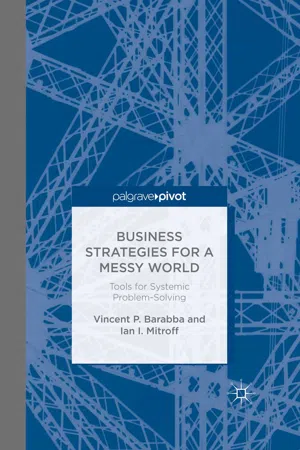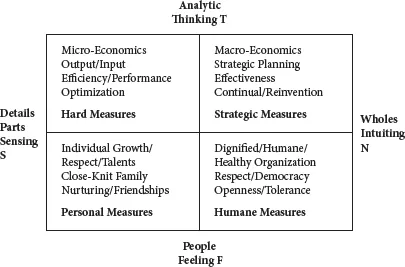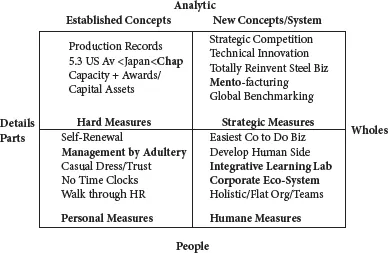
eBook - ePub
Business Strategies for a Messy World
Tools for Systemic Problem-Solving
V. Barabba,I. Mitroff
This is a test
- English
- ePUB (disponibile sull'app)
- Disponibile su iOS e Android
eBook - ePub
Business Strategies for a Messy World
Tools for Systemic Problem-Solving
V. Barabba,I. Mitroff
Dettagli del libro
Anteprima del libro
Indice dei contenuti
Citazioni
Informazioni sul libro
Using current business examples and academic research, Tools for Systematic Problem-Solving educates managers and executives on how to systematically examine key assumptions to ensure survival and success for their organizations.
Domande frequenti
Come faccio ad annullare l'abbonamento?
È semplicissimo: basta accedere alla sezione Account nelle Impostazioni e cliccare su "Annulla abbonamento". Dopo la cancellazione, l'abbonamento rimarrà attivo per il periodo rimanente già pagato. Per maggiori informazioni, clicca qui
È possibile scaricare libri? Se sì, come?
Al momento è possibile scaricare tramite l'app tutti i nostri libri ePub mobile-friendly. Anche la maggior parte dei nostri PDF è scaricabile e stiamo lavorando per rendere disponibile quanto prima il download di tutti gli altri file. Per maggiori informazioni, clicca qui
Che differenza c'è tra i piani?
Entrambi i piani ti danno accesso illimitato alla libreria e a tutte le funzionalità di Perlego. Le uniche differenze sono il prezzo e il periodo di abbonamento: con il piano annuale risparmierai circa il 30% rispetto a 12 rate con quello mensile.
Cos'è Perlego?
Perlego è un servizio di abbonamento a testi accademici, che ti permette di accedere a un'intera libreria online a un prezzo inferiore rispetto a quello che pagheresti per acquistare un singolo libro al mese. Con oltre 1 milione di testi suddivisi in più di 1.000 categorie, troverai sicuramente ciò che fa per te! Per maggiori informazioni, clicca qui.
Perlego supporta la sintesi vocale?
Cerca l'icona Sintesi vocale nel prossimo libro che leggerai per verificare se è possibile riprodurre l'audio. Questo strumento permette di leggere il testo a voce alta, evidenziandolo man mano che la lettura procede. Puoi aumentare o diminuire la velocità della sintesi vocale, oppure sospendere la riproduzione. Per maggiori informazioni, clicca qui.
Business Strategies for a Messy World è disponibile online in formato PDF/ePub?
Sì, puoi accedere a Business Strategies for a Messy World di V. Barabba,I. Mitroff in formato PDF e/o ePub, così come ad altri libri molto apprezzati nelle sezioni relative a Business e Information Management. Scopri oltre 1 milione di libri disponibili nel nostro catalogo.
Informazioni
Argomento
BusinessCategoria
Information Management1
Chaparral Steel—A Model Systems Design
Abstract: By means of an actual business case, this chapter shows how the personality typology of the eminent Swiss psychiatrist and psychoanalyst Carl Jung gives rise to a unique form of systems analysis. That is, the Jungian personality typology may have originated in the desire to understand individual personality differences, but it is not confined to the study of individuals alone. For example, organizations and even systems have a “personality” in that they display distinct preferences for different forms and types of information and ways of making decisions based on what they consider to be information.
The chapter argues that something is a problem if and only if it has important components in each of the Jungian personality quadrants or types.
Barabba, Vincent P., and Mitroff, Ian I. Business Strategies for a Messy World: Tools for Systemic Problem-Solving. New York: Palgrave Macmillan, 2014. DOI: 10.1057/9781137386403.
Open up any one of a number of popular business books and you’ll hear the same models of excellence touted again and again: Google, Facebook, etc. We have no problems with these examples. We even agree with them. But since they are used repeatedly, we want to use a different one that has remained excellent for a long period of time.
Located in the rolling hills of central Texas, Chaparral Steel is one of the very few U.S. companies that survived the onslaught of competition from foreign steel mills—primarily Japanese—in the 1970s. Coupled with its intense, on-going commitment to the latest technology and its highly flexible and innovative management practices, Chaparral not only revolutionized the U.S. steel industry, but in 1992 it became the world’s lowest-cost producer of steel. As part of its success story, it was acquired by the Gerdau Ameristeel Corporation in 2007.
Throughout its long and distinguished history, Chaparral Steel has been and is a model company. It is one of the best examples we know of an organization that has been conceived of and managed as a total integrated system.
We’re going to describe the accomplishments and operation of Chaparral Steel in terms of a very different approach to systems thinking. The approach embodies fundamentally different perspectives and styles of decision-making. In other words, we’re not going to use the widespread and commonly accepted notion of a system as a bunch of boxes composed of key activities, decisions, and/or processes with a complex tangle of arrows running each and every which way between them. In this view, the arrows represent the multiple interactions and feedback loops between the various elements that comprise a system.
It’s not that this more common notion of systems is wrong. Rather, it leaves out some of the most crucial aspects of systems in terms of how different types of people and technologies not only depend on each other, but also have to work together seamlessly. If they are not able to work together, then a system can’t even exist in the first place, let alone accomplish its intended goals. In this sense, since it leaves out vital aspects, the common approach to discussing systems is not systemic in the truest sense of the term.
The process we will use in discussing systems is based on the pioneering work of the Swiss psychiatrist and psychoanalyst Carl Jung. It pinpoints the different types of activities and processes that are essential if companies and organizations are to survive, and, even more, to prosper in today’s highly dynamic and complex world.
Chaparral Steel as a totally integrated system
Figure 1.1 describes the four essential sets of activities that any organization needs to perform. The essential activities fall into four distinct quadrants. In addition, the leadership of an organization needs to ensure that the four quadrants not only support one another, but also work together seamlessly if any of them are to be successful. In other words, acting alone, none of the quadrants can succeed by themselves.
In order to understand the meaning of Figure 1.1, let us briefly describe its underlying dimensions.
The horizontal dimension refers to how one initially represents, structures, or views a complex entity. The vertical dimension refers to how one analyses, responds to, or uses a process to make an important decision.
Taken together, the two dimensions compose two of the key aspects of the Jungian Framework. Jung observed that no matter what the field of human endeavor, the same two dimensions emerged repeatedly. The two dimensions captured the differences between how different people viewed any situation or field of human knowledge and/or practice.
The left-hand side “Details Parts” refers to the fact that no matter what the particular entity or situation, there is always the perspective or point of view that instinctively breaks a complex whole (problem, situation, system, etc.) down into its so-called separate, individual parts and then analyses/studies the parts in isolation. In other words, some people are comfortable if and only if they can break a complex problem or system down into its “individual parts” so that they can focus solely on the parts alone. The left-hand side also represents those aspects of a system that can be understood in terms of established concepts and measures.

FIGURE 1.1 Chaparral Steel—the Jungian Framework
The left-hand side is called Sensing or S for short. Sensing type personalities—people whose S side is strongly developed—prefer to gather information in terms of their senses. In fact, anything that isn’t ultimately based on or reducible to the senses isn’t considered to be “information.”
The right-hand side “Wholes” stands for those who instinctively prefer not to break something down into its so-called “parts.” Instead, they prefer to look at the whole of any entity or situation. If they do look at the “parts,” it is not only to draw out all of the interconnections between them, but to create a whole whose value as a whole is greater than the product of the value of the individual parts. In other words, they don’t look at anything in isolation. Finally, the right-hand side also represents the use of non-traditional concepts, ideas, and measures to assess the performance of a system.
The right-hand side is called Intuiting or N for short. Intuiting type personalities—people whose N side is strongly developed—prefer to gather information in terms of their imagination. In fact, anything that isn’t ultimately based on imagination isn’t information. In other words, facts hem Ns in. It’s not that facts don’t matter, but today’s facts have a way of becoming the discarded realities of yesteryear. In other words, facts only matter in the aggregate, not in isolation.
The top of the vertical dimension, “Analytic,” represents the use of impersonal ways (logic, science, statistics, etc.) of analyzing entities and situations, and making decisions. The bottom “People” represents the use of one’s personal feelings to assess a person, organization, or situation. The bottom also represents looking at an organization, situation, etc. in intensely personal and human terms.
In terms of the Jungian Framework, the top of the vertical dimension is called Thinking or T for short. Thinking type personalities—people whose T side is strongly developed—prefer to analyze situations impersonally. In sharp contrast, Feeling or F types respond to every situation in intensely personal terms. It’s not that one type is “right” and the other is “wrong,” but that both need and depend upon one another in order to pick up and respond appropriately to everything that is involved in every situation.
Putting the horizontal and vertical dimensions together results in the four quadrants in Figure 1.1. With these ideas in mind, let’s look at Figure 1.2 to get a better understanding of Chaparral.
Systems’ issues
While Figure 1.1 provides an understanding of the general issues with which each of the four quadrants is concerned, Figure 1.2 illustrates how Chaparral is truly a systems organization in that not only are all of the four quadrants developed equally, but there is the realization that none of the aims and objectives in any one of the quadrants can be attained without the others. We cannot emphasize too much that it is not an issue of what quadrant is “right or wrong,” but by itself, each quadrant only picks up a small percentage of the full set of issues that must be dealt with in any complex organization if it is to be successful and thus to exist for any extended period of time.
The items in red are those to which we pay special attention, for they are truly what set Chaparral apart from other organizations.

FIGURE 1.2 Chaparral Steel—the “facts” of the case
Figure 1.2 shows that in terms of “hard measures” in the upper, left-hand quadrant, Chaparral Steel excels. Chaparral greatly outperforms its competitors financially because of all the things it is doing in all of the quadrants.
This is a remarkable feat for any company, but it is especially remarkable for one that is primarily technical. On the whole, technical companies do not generally perform well on the “people or Feeling quadrants,” and not-for-profit, social service organizations do not generally perform well on the technical and financial or Thinking quadrants.
Chaparral constantly sets records for the production of steel and the efficiency of its operations. It generally beats all of its competitors in terms of production and finance. Thus, in terms of operational considerations and measures alone (the upper left-hand or ST [Sensing-Thinking] quadrant), Chaparral is not only outstanding, but is a clear leader in its field.
In terms of the upper, right-hand or NT (Intuitive-Thinking) quadrant, Chaparral excels in innovative, strategic thinking. At any point in time, literally every person in the organization is taking a class of some sort that is not only concerned with the reinvention of the organization, but of the entire steel manufacturing business. That’s why Chaparral refers to itself as a “mento-facturing” organization. It is in the mental manufacturing business. It is not merely a traditional physical manufacturing organization as the term is currently understood and applied.
The bottom, right-hand NF (Intuitive-Feeling) quadrant refers to the fact that Chaparral not only strives to be the easiest company with which to do business, but that first and foremost, it’s an ethical human community. It works continually to develop and present a human face to itself and to the outside world.
The bottom, left-hand SF (Sensing-Feeling) quadrant extends the ideas in the left-hand quadrant in terms of the pithy phrase “Management by Adultery.” Chaparral obviously does not mean “adultery” in a sexual sense. Rather, it treats its employees as adults. For example, it trusts its employees in submitting travel expenses. It doesn’t treat them as potential crooks. As a result, it saves considerable time and money in reviewing travel expenses.
Where problems come from
The Jungian Framework gives a very important answer to the important question, “Where do problems come from?” It is no great surprise to say that like all things human, in the first and last resort, problems basically come from people and their institutions. On the other hand, it is a revelation to understand why different people see entirely different problems.
Problems do not fall out of the sky fully formed and completely well specified. Rather, they emanate from deep inside of us. Problems originate from the most basic parts of our “individual” and “social personalities,” that is, from the societies in which we live and of which we are fundamental parts.
A generalized organizational problem form...
Indice dei contenuti
- Cover
- Title
- 1 Chaparral SteelA Model Systems Design
- 2 Critical ArgumentsThe Toulmin Argumentation Schema (TAS)
- 3 AssumptionsStrategic Assumption Surfacing and Testing (SAST)
- 4 A Critical ApplicationThe U.S. Census Bureau
- 5 Complex Messy Systems
- 6 SynthesisPutting It All Together
- Appendix: The Census Privacy and Data Use Workshop
- Index
Stili delle citazioni per Business Strategies for a Messy World
APA 6 Citation
Barabba, V., & Mitroff, I. (2013). Business Strategies for a Messy World ([edition unavailable]). Palgrave Macmillan US. Retrieved from https://www.perlego.com/book/3487855/business-strategies-for-a-messy-world-tools-for-systemic-problemsolving-pdf (Original work published 2013)
Chicago Citation
Barabba, V, and I Mitroff. (2013) 2013. Business Strategies for a Messy World. [Edition unavailable]. Palgrave Macmillan US. https://www.perlego.com/book/3487855/business-strategies-for-a-messy-world-tools-for-systemic-problemsolving-pdf.
Harvard Citation
Barabba, V. and Mitroff, I. (2013) Business Strategies for a Messy World. [edition unavailable]. Palgrave Macmillan US. Available at: https://www.perlego.com/book/3487855/business-strategies-for-a-messy-world-tools-for-systemic-problemsolving-pdf (Accessed: 15 October 2022).
MLA 7 Citation
Barabba, V, and I Mitroff. Business Strategies for a Messy World. [edition unavailable]. Palgrave Macmillan US, 2013. Web. 15 Oct. 2022.